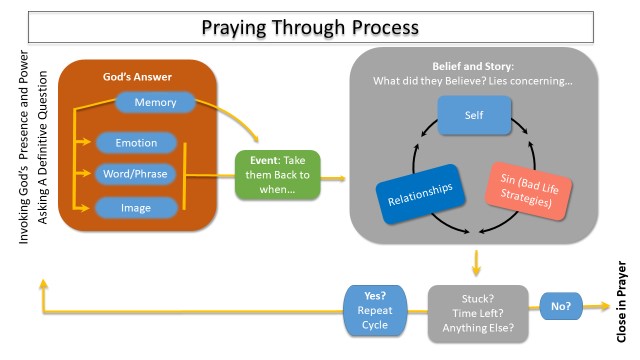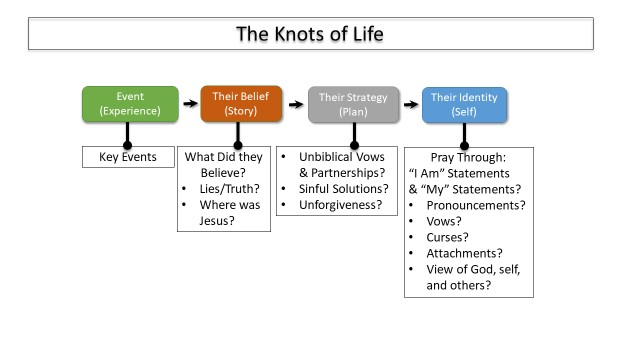The basic approach of a 90 minute Pray Through It Session can be summarized as follows: Step one, begin by dedicating the room and all prayer participants in prayer, asking God to bring us into a posture of listening (minds at rest and hearts at peace). Step two, after listening briefly to the prayer recipient, pose a question to God. Step three, listen for a response from God in prayer in the form of a memory, emotion, word/phrase, or image. Step four, ask God to protect them from the pain of past memories as He reminds them of the time in their life when this became a part of them. Step five, partner with them to listen to God as He reveals and re-frames any false views of their identity in relation to God and others and their bad life strategies (called sin). And finally, step six, close in a prayer of thanksgiving and dedication.
This chart overviews what it could look like to pray through it:

Note that the process is cyclical. Lies concerning the self, relationships, and our life strategies are intertwined much like a knotted ball of string. Therefore, during any session, you will want to strategically focus on getting as many of the biggest knots out as quickly and effectively as you can within that time. In the process, you will likely need to untie several important smaller knots in the process in order to move forward on the bigger knots. This means that during any prayer session, you may at times need to briefly pause from the big knot, cycling through steps 2-5, in order to have mini prayer sessions on smaller knots before returning to untie the bigger knot.

For example, as you are praying with someone about letting go of their worry, you might discover that their worry masquerades as something serving a useful purpose, making it hard for them to give up. You would then shift to discovering that purpose, uncovering and dealing with the lie that is holding it in place in order to help them surrender their worry along with the lie that is holding it in place. You will likely do this several times (sometimes many times) within a single prayer session within your 60-90 minute session. However, by the end of your session, you and the one you are praying with will almost always have a linear understanding of how an event led to a knotted lie that lead to a knotted belief that lead to a knotted life strategy. In addition, not only will they understand the way they were (note the past tense here), they will now be free from the knots caused by unbiblical vows, partnerships, discipleship, pronouncements, “I am” and “my” statements, curses, sinful solutions, lies, etc. As the string is unknotted, you will be able to recount together how all of these things were inter-related (See chart below).
A couple of things are of note at this point. First, it is important to note that what is being advocated here is not step-by-step methods or processes, but an understanding of the relationship between how what we believe affects how we view and approach the world. And more importantly, the extent of your success with this approach will hinge greatly upon your willingness and ability to step aside to allow God to guide the healing process. Once you are willing to do this, you will find yourself sitting in a front row seat to see God working to transform people in prayer right before your eyes. People will come in brokenness and they will leave no longer conformed to this world, but transformed by the renewing of their minds (Romans 12:2). They will understand anew Jesus’ promise to take their heavy burdens and to grant them rest (Matthew 11:28-30). They will understand what it feels like to cast their cares upon the Lord and to receive the peace that surpasses all understanding (Philippians 4:7). And I can tell you, for me, there is no better way to spend an hour of my life than to watch God heal the broken-hearted, release the captives and set prisoners free (Luke 4:18)!
Who knew that these catchy sayings of Christianity actually described a powerful spiritual reality?

